Did you know that Gary Halbert, one of the world’s best copywriters, was sentenced to prison in the 1980s for tax fraud?
Yep.
He served his sentence in the Boron Federal Penitentiary, where he sent his son letters. Hence the name of his book, The Boron Letters.
But Gary didn’t just have a fascinating past. The man was a legend in the copywriting world.
He wrote sales copy for household names Rolls-Royce and campaigns that generated millions of dollars.
Needless to say, we can learn a thing or two from him.
This article is going to cover Gary Halbert’s copywriting examples and takeaways to instantly improve your writing.
Million dollar smile

This advertorial was written to educate readers on two things: firstly, porcelain veneers are the most cost-effective and best way to get a Hollywood smile. Secondly, Dr. Thomas Gleghorn is the only dentist you should visit to get veneers.
It’s a classic advertorial. It educates you on a specific topic, dental veneers, in this case, with the advertising subtly mixed in.
Think of it like a nice martini that doesn’t have a hint of liquor.
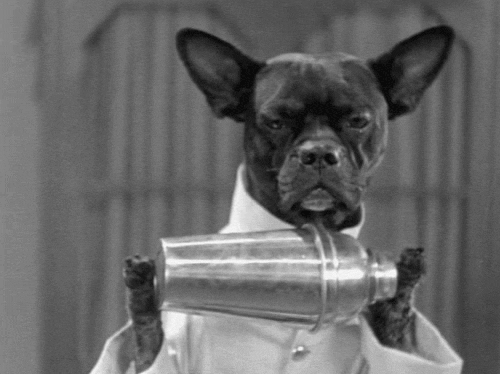
Gary does an amazing job talking about the benefits of a great smile, including that smiling releases brain chemicals that put you in a better mood.
He also talks about the emotional reasoning behind why people are ashamed of their teeth to target the customer’s pain points.
Halbert then provides the solution: porcelain veneers.
Bullet points are used to quickly summarize the main benefits of the procedure, such as porcelain is strong and durable, it makes you look younger, it’s a quick process, and it realigns your teeth.
Right after this, Gary handles the objections customers may have. Primarily it’s worrying about the procedure time or feeling that they’re not worthy of a beautiful smile.
Finally, he introduces the doctor who can work his magic on anyone’s smile to produce these incredible results.
A small box details Dr. Thomas Gleghorn’s credentials and experience, which builds trust with readers.
The advertorial ends with a call to action for contacting the doctor. Gary also uses a sense of urgency that he is very busy and you should call immediately to book a spot if you’re interested in veneers.
I know there are a lot of strategies going on. That’s why I suggest using a tool like Jasper to help you write and come up with ideas.
Main takeaways
- Clearly address the reader’s pain points to get them emotionally stimulated while reading sales copy.
- Talk about the emotional and experiential benefits of products versus only stating the facts.
- Handle objections preemptively to help readers get through the sales copy.
- Use bullets to quickly summarize important information.
- Use calls to action and urgency to increase response.
Related content: dental copywriting and dental practice marketing.
1,300 year old health secret
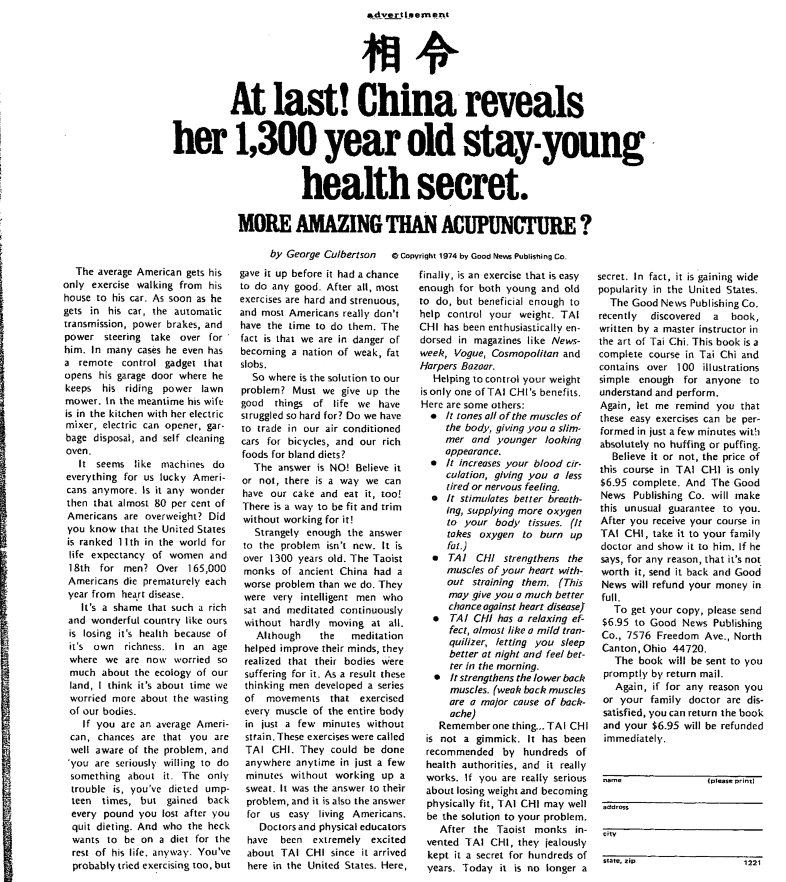
This ad instantly draws you in with the alluring and mysterious headline claiming that China reveals an ancient health secret that keeps you young.
Better yet, the sub-headline raises the question, “More Amazing Than Acupuncture?”
Well, I guess we have to read the ad to find out!
The ad begins with an unfortunate fact about the average American: he only gets his exercise walking from house to his car.
The technology handles all of his chores on top of this. Gary uses the statistic that 80% of Americans are overweight to back up his claim that 165,000 Americans die from heart disease each year.
It packs an emotional punch and sounds authoritative because of the data.
Halbert addresses the pain points of trying diets and failing, exercising without results, and feeling too tired from workouts.
He introduces the Taoist monks of ancient China and what they found 1,300 years ago … the discovery of a way to exercise the entire body in just a few minutes. A.K.A Tai Chi.

You don’t have to break a sweat. You can do them anywhere. At any time.
You can be young. You can be old. And you can finally be in control of your weight.
Halbert uses names like Vogue, News-Week, and Harpers Bazaar to build credibility before going into the benefits of Tai Chi.
These include muscle tone, looking younger, better blood circulation, improved breathing, heart health, and relaxation.
Finally, Gary Halbert introduces what he’s selling: a book that contains over 100 illustrations simple enough for anyone to follow on Tai Chi exercises.
With a full money-back guarantee, the $6.95 price point is introduced along with a call to action for a response at the bottom.
Main takeaways
- Build up anticipation by using mystery, science, and data before introducing the product.
- Leverage a concept like Gary Halbert did with 1,300 year old ancient Taoist monks to uniquely position a product.
- Use names of publications and institutions to build credibility.
- Clearly explain money-back guarantees to increase conversions.
You can see more examples like these in my copywriting training.
The U.S. Government owes you
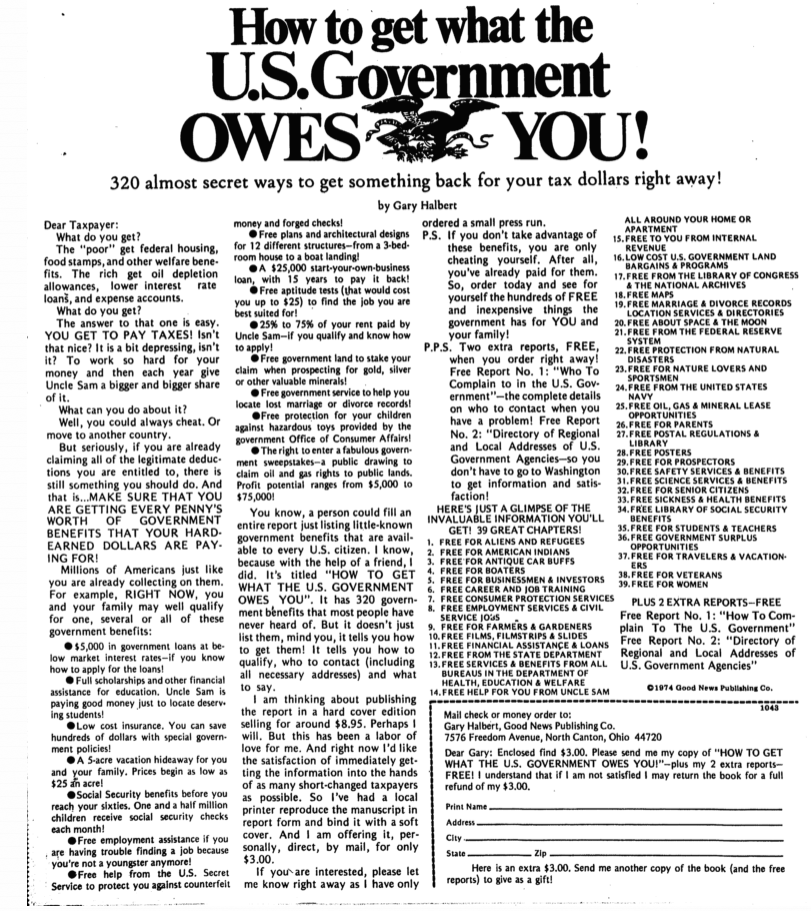
This is an advertisement written by Gary Halbert that sold a report of 320 ways to get money and benefits from the U.S. Government.
The headline was written to interest any American who believed the Government was taking too much while giving back too little.
The sub-headline supports it by explaining there are 320 “almost secret” ways to get something back for your tax dollars quickly.
You can learn more about headline copywriting in my related video:
Halbert immediately addresses pain points such as welfare, federal housing, and food stamps while the rich get lower interest rates and allowances.
He positions the ad as the average American versus “the man.”
You have to work hard for your money only for it to be taken away from Uncle Sam.
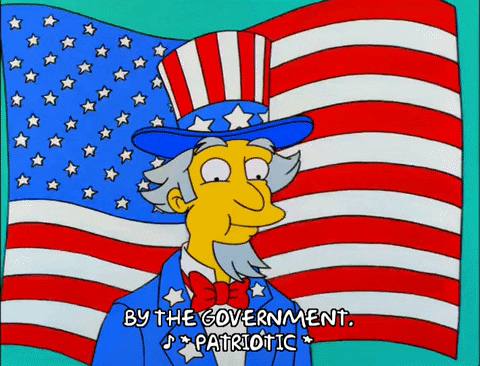
The advertisement introduces the idea that there are benefits every American can get but aren’t taking advantage of.
Some of them include $5,000 in government loans, full scholarships, and low-cost insurance.
The reader is quickly blown away by all of the financial benefits they can gain if they understand what government programs they can apply for and receive.
Gary Halbert lists all of these in bullet format to make it easily digestible.
The report is sold for $3.00 via direct mail, but Gary notes that he’s considering selling a hardcover edition for $8.95. This creates a sense of urgency that readers must act fast, or they’ll have to spend more money later.
The first PS. Includes a reminder that there are hundreds of free things the government has waiting for you and your family.
The second P.S. says that customers will receive two free reports if they order right away, which compliments the product.
There is a summary of the first 39 chapters of the book as a preview of the product before the mailing form is placed at the bottom.
Main takeaways
- Position offers as “secret” if possible to create a sense of mystery and interest.
- Use bullet points to quickly summarize product information and benefits.
- Offer bonuses as a way to increase response and deliver increased value.
- Give a preview of the product if it’s a book, course, etc.
Amazing new formula from Beverly Hills
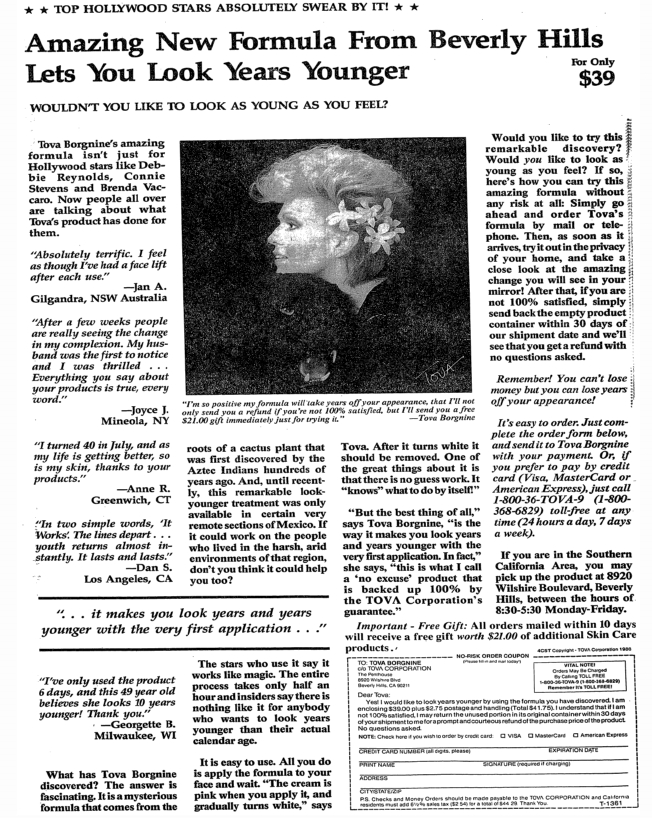
This is an advertisement written by Gary Halbert for an anti-aging skin cream.
Notice how it says, “Top Hollywood Stars Absolutely Swear By It!” to build trust and authority.
The headline is straightforward and benefit-driven, stating, “Amazing New Formula From Beverly Hills Letters You Look Years Younger.”
The price is found on the right side, and the advertisement asks, “Wouldn’t you like to look as young as you feel?” to directly engage readers and one of their pain points (looking old).
The left side of the advertisement includes testimonials from happy customers, which act as social proof. Remember, 92% of consumers read reviews when considering a purchase.
Gary Halbert positions the product not as an ordinary skin cream you can get anywhere but rather as a mysterious formula that comes from the roots of a cactus plant discovered by Aztec Indians hundreds of years ago.
Until recently, this formula was only available in remote parts of Mexico.
This position makes the product appear unique, rare, and one-of-a-kind.
The advertisement talks about how easy the product is to use and how fast the results happen. Both of these are important to overcome objections.
A 100% product guarantee makes the offer that much more believable and concrete.
The ad asks readers to place an order if they want to look younger and instructs them on how to do so easily.
Main takeaways
- Use testimonials to build trust with readers and increase response.
- Place relevant photos in the advertisement to support the sales copy.
Famous dollar letter

Here’s a cool one.
This is a famous eight-page letter written by Gary Halbert that included a real one dollar bill at the top of the letter.
It’s outside of the box. Unique. Attention-grabbing.
After all, who isn’t going to read a letter that includes free money?
Gary states that he did this for two reasons:
- To get the reader’s attention as he has something “very important” to tell them.
- The offer has something to do with making more money, so it’s very relevant.
The reader has already won by getting free money; reading the sales copy isn’t a big deal.
This letter was sent out to people who responded to a previous ad he sent out in the Wall Street Journal.
It’s an information package that contains “incredible secrets” about growing a business, generating income, increasing cash flow, getting TV stars to sell your products, and more.
Gary uses a nice numbered list to summarize the previous benefits of the original ad.
He selects the audience by saying, “If you’re interested in creating a huge (and immediate) cash flow for yourself or your business, this is going to be the most exciting message you will ever read.”
This gets readers thinking, “Hey, that’s me!” before explaining Gary’s background of being dead broke and bankrupt. He couldn’t pay rent. He was desperate. It’s an effective way to create emotion and continue hooking the reader’s attention. Many people can relate, as well.
That’s when he introduces the “crazy idea” of getting people to send him money by sending out letters.
He asks various questions that once again select the audience, such as salesmen who need more leads, businesses that want to be swamped with customers, and consultants who need more clients.
The sales letter is neatly broken down into different sections with headers, underlined text, and capitalized sentences. It’s easy to read and understand.
Gary presents his course that has been used to generate tens of millions of dollars. It includes two sets of cassette tapes and six written reports.
Customers are able to trust it risk-free for one year.
He tells people to place their orders and clearly explains the steps to do so.
One thing I love about Gary’s work is that it uses all of the fundamental copywriting and advertising strategies beautifully.
Check out the full sales letter here.
Main takeaways
- The bigger the offer, the more sales copy you need to write to accommodate information, objections, and questions.
- Brainstorm ways your campaign can instantly stand out and go viral, as Gary did by attaching a one dollar bill.
- Clearly select the audience and ask them contextual questions, so they know they’re reading something relevant.
Wrapping up today’s Gary Halbert copywriting examples
Gary Halbert is one of the best copywriters ever.
Point, blank, period.
And, if you want to sharpen your skills, nothing is better than learning from the pros.
I recommend going through other examples, including the ones I covered today, and taking notes.
What strategies did he use?
How did he position products?
What patterns in formatting and structure do you see?
You get my point.
Schedule a free consultation to learn more about my marketing services that will help your business drive more revenue.














